Lenovo ThinkStation P300 Workstation Review: Haswell plus Quadro
by Ian Cutress on November 4, 2014 10:00 AM EST- Posted in
- Systems
- Intel
- Lenovo
- Seagate
- Quadro
- Workstation
- Haswell
- desktops
- Enterprise
- NVIDIA
System Benchmarks
Power Consumption
Power consumption was tested on the system at the wall. This method of power reading allows us to compare the power management of the UEFI and the board to supply components with power under load, and includes typical PSU losses due to efficiency. These are the real world values that consumers may expect from a typical system (minus the monitor).

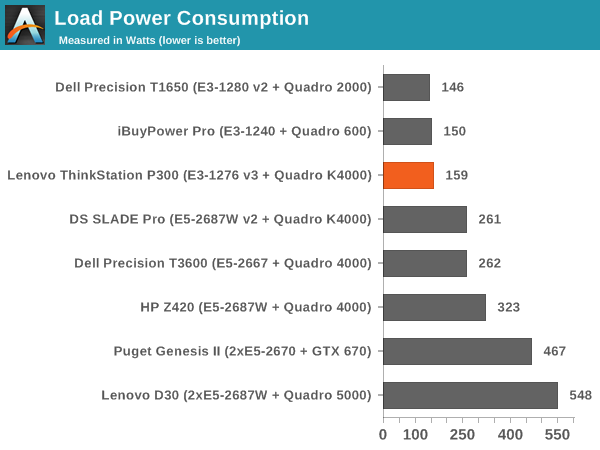
Power consumption on the P300 was pretty amazing due to the very efficient power supply used.
Windows 7 POST Time
Different motherboards have different POST sequences before an operating system is initialized. A lot of this is dependent on the board itself, and POST boot time is determined by the controllers on board (and the sequence of how those extras are organized). As part of our testing, we look at the POST Boot Time using a stopwatch. This is the time from pressing the ON button on the computer to when Windows 7 starts loading. (We discount Windows loading as it is highly variable given Windows specific features.)
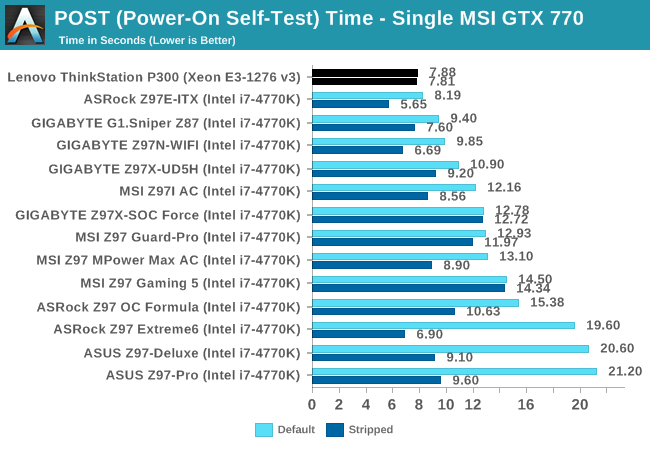
POST Times were also right on the money, giving some of our best POST times ever.
Rightmark Audio Analyzer 6.2.5
Rightmark:AA indicates how well the sound system is built and isolated from electrical interference (either internally or externally). For this test we connect the Line Out to the Line In using a short six inch 3.5mm to 3.5mm high-quality jack, turn the OS speaker volume to 100%, and run the Rightmark default test suite at 192 kHz, 24-bit. The OS is tuned to 192 kHz/24-bit input and output, and the Line-In volume is adjusted until we have the best RMAA value in the mini-pretest. We look specifically at the Dynamic Range of the audio codec used on board, as well as the Total Harmonic Distortion + Noise.

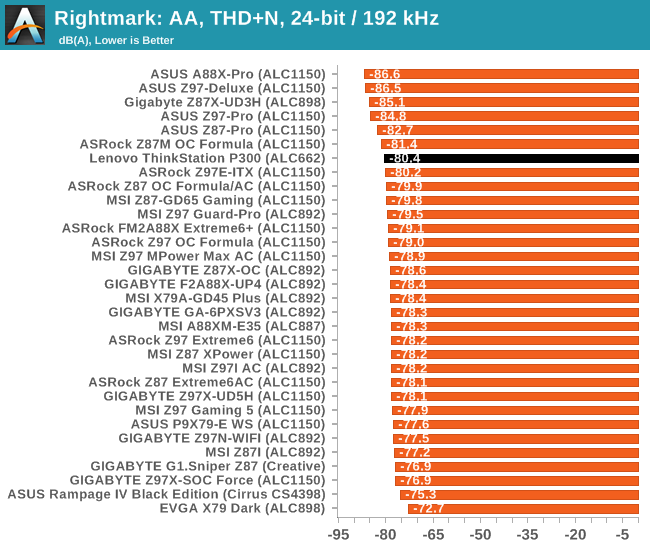
Unfortunately the audio performance for SNR was rock bottom due to the laptop-class codec used. THD+N was reasonable, although just above the median.
USB Backup
For this benchmark, we transfer a set size of files from the SSD to the USB drive using DiskBench, which monitors the time taken to transfer. The files transferred are a 1.52 GB set of 2867 files across 320 folders – 95% of these files are small typical website files, and the rest (90% of the size) are small 30 second HD videos. In an update to pre-Z87 testing, we also run MaxCPU to load up one of the threads during the test which improves general performance up to 15% by causing all the internal pathways to run at full speed.
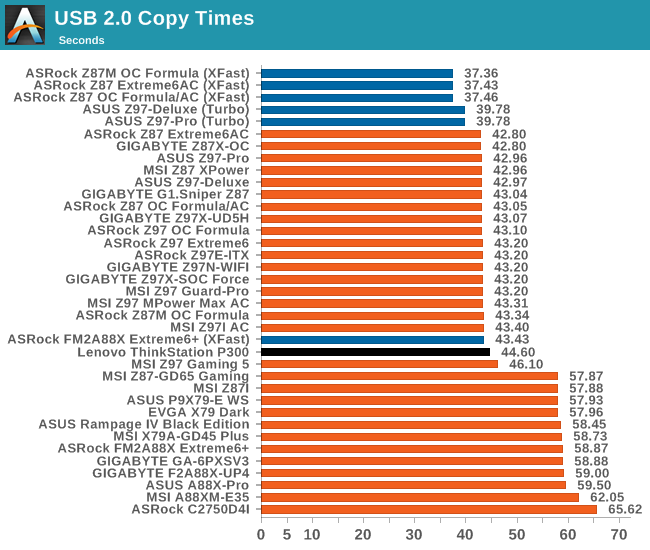
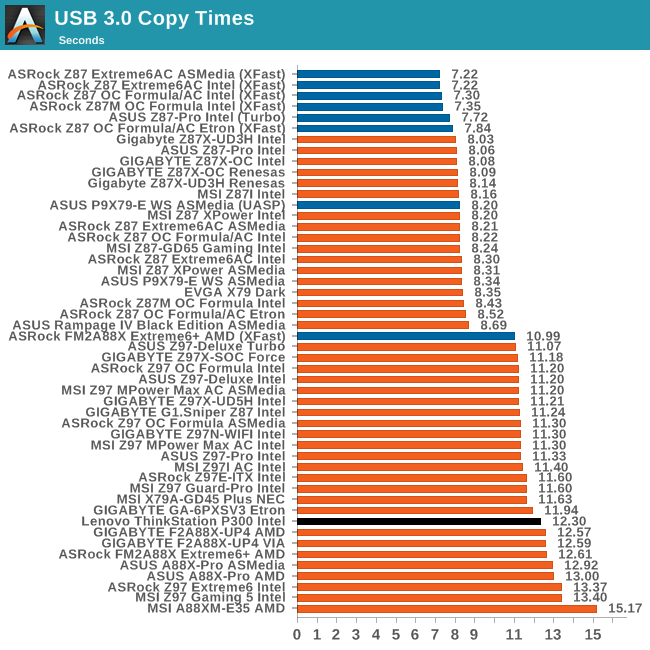
USB Performance seemed to lag behind the other motherboards that also accept Haswell CPUs.
DPC Latency
Deferred Procedure Call latency is a way in which Windows handles interrupt servicing. In order to wait for a processor to acknowledge the request, the system will queue all interrupt requests by priority. Critical interrupts will be handled as soon as possible, whereas lesser priority requests such as audio will be further down the line. If the audio device requires data, it will have to wait until the request is processed before the buffer is filled.
If the device drivers of higher priority components in a system are poorly implemented, this can cause delays in request scheduling and process time. This can lead to an empty audio buffer and characteristic audible pauses, pops and clicks. The DPC latency checker measures how much time is taken processing DPCs from driver invocation. The lower the value will result in better audio transfer at smaller buffer sizes. Results are measured in microseconds.

DPC Latency for the system was also relatively poor. Intel's 9-series made us rethink the milestone in terms of a good level of performance from 200 microseconds to 100 microseconds. The P300 hits the old target rather than the new one.










55 Comments
View All Comments
jabber - Tuesday, November 4, 2014 - link
Though I probably wouldn't buy one of these as they seem way too limited and the build quality is cheap for a Workstation.SkiBum1207 - Tuesday, November 4, 2014 - link
On the overview page, about half way down, there's a picture of the intake fan with some sort of a shroud on it - what is the purpose of the shroud? I could maybe understand an increase in velocity and static pressure, but it seems like it would cut airflow by 80% - Coming from the land of rack units where cfm is king, am I missing something here?mfenn - Tuesday, November 4, 2014 - link
I love how Ian nitpicks internal layout decision in the name of improving airflow, but fails to present any CFD modeling or empirical testing to support his viewpoints. Gives a nice sheen of "I'm an enthusiast who knows more about case design than mechanical engineers" to the whole thing. Well done!But seriously Ian, you should not make objectively provable (or disprovable) claims without providing appropriate evidence. There are definitely time considerations to take into account during the review process, and obviously everything cannot be tested if the review is to ever come out. However, in such instances, you should stick to presenting the facts and letting readers draw their own conclusions instead of adding flippant and potentially false statements to the review.
Oscarcharliezulu - Wednesday, November 5, 2014 - link
If the writer didnt add an opinion then wouldn't the article just be a spec sheet?duploxxx - Tuesday, November 4, 2014 - link
very poor design and cablingdgingeri - Tuesday, November 4, 2014 - link
a single non-ECC 8GB DIMM and a 1TB SSHD for storage, for $2274. What an incredibly overpriced piece of junk. I could build one with this same processor, a workstation level motherboard, 16GB of ECC memory, a 256GB 850 Pro SSD for the OS and a 3TB Hitachi Ultrastar (pro level) drive for storage, including the Windows 8.1 Pro license, for less than three quarters of this price. It is SO not worth $600 for Lenovo support and warranty.Gigaplex - Wednesday, November 5, 2014 - link
With what GPU? That's where the bulk of the costs went.SuperVeloce - Tuesday, November 4, 2014 - link
What the hell is this with non-standard 24pin power motherboard connector? Are they out of their minds?DanNeely - Tuesday, November 4, 2014 - link
Dunno; OTOH the target market for something like this would never service it except via waranty so it wouldn't matter; and the 24pin ATX connector is really out of sync with modern systems needs; specifically the 5x 3.3 and 5x 5v are way over what a modern system needs and unless you're doing RS232 the -12v is useless too. 3.3 is going the way of the dodo since it's only used by legacy PCI now; and USB doesn't need anywhere as much 5V as a P1 system does. Spitting the connector would theoretically help with cable management by making the bundles slimmer; and adding more spread out connection points on the board makes it easier to maintain stable voltages everywhere.Gigaplex - Wednesday, November 5, 2014 - link
Dell have started doing this again recently too. My previous Dell workstation is far more flexible than my current one. I'm also not happy with the lack of air flow over the hard drives. I've had several drive failures that might be attributed to overheating. This Lenovo looks like it has similar issues but at least it has a fan on the front.